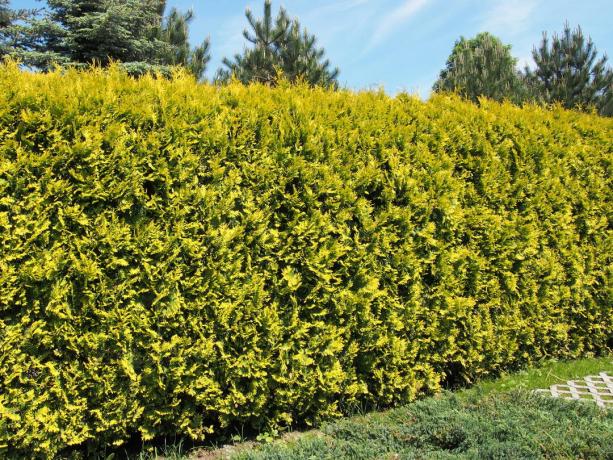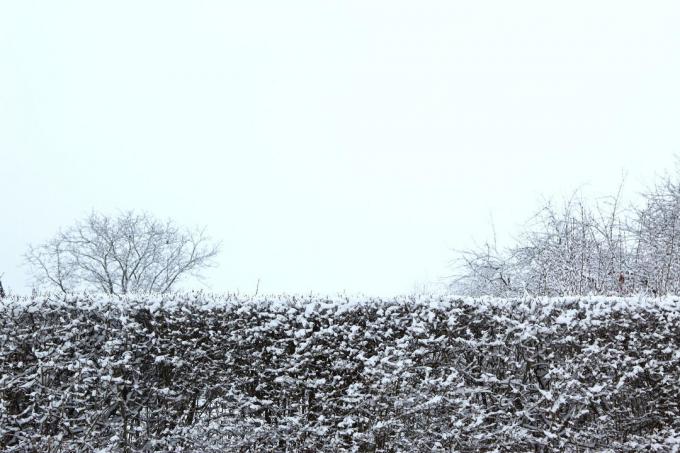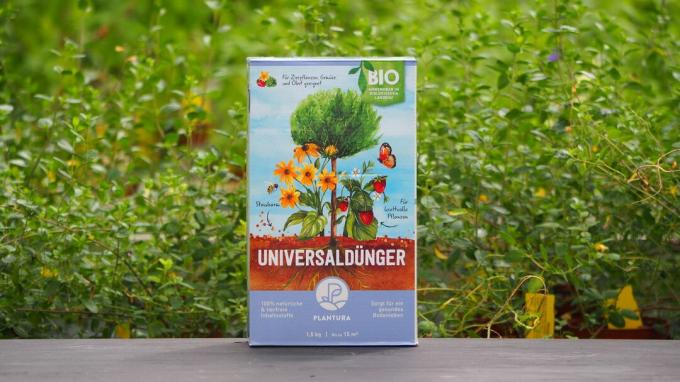In order for them to fulfill their purpose and be opaque, hedges must be properly fertilized. Here you will find everything you need to know about fertilizing hedges.

A hedge offers the optimal property boundary for friends of a green garden. They form a wonderfully natural privacy screen and keep uninvited neighbors away. However, the botanical variant is not only more attractive than the variants made of dead material - such as wooden fences and Co. It is also A little more maintenance-intensive, because hedge plants need to be kept in shape, watered and occasionally supplied with a little fertilizer will. This is the only way for your hedges to form green foliage even on semi-optimal soil and to sprout vigorously again every year. Unfortunately, there is no universal hedge fertilizer, because hedges are not a plant species, but a plant species. Nevertheless, there are some general things to consider that you can hardly go wrong with most hedge plants.
Hedge plants want to be fertilized, that's no question. But depending on whether you have coniferous or deciduous trees, whether the plants are evergreen or just deciduous and how fast the selected hedge plant grows, the fertilizer requirement can vary. While this may sound like a science in itself, hedge plants are fundamentally similar in terms of when to fertilize and which fertilizers should be used.
contents
-
When to fertilize the hedge?
- Fertilize hedges in spring
- Fertilize hedges in summer
- Fertilize hedges in autumn
-
The right hedge fertilizer
- Fertilize hedges organically
- Organic long-term fertilization: instructions for hedges
- Fertilize hedges with minerals
- Fertilize hedges with home remedies: horn shavings and co.
Anyone who is still planning their leafed property boundary will find a few in particular here easy-care hedge plants for his garden.
When to fertilize the hedge?
Whether directly at hedge planting Fertilization is necessary depends on the soil conditions and the plant material purchased. Container goods usually already contain a long-term fertilizer and must be fertilized at the earliest four weeks after planting, usually even in the following year. In the case of bare-root goods and if the chosen location only offers very poor, sandy soil, you should not do without the plant fertilization. Mature compost and horn shavings are mixed into the excavated soil. In this way, most hedge plants are supplied with sufficient nutrients until the following year. Never use a mineral fertilizer. This is too highly concentrated for the still weakly developed roots and leads to root burns.

Fertilize hedges in spring
The regular fertilization of your garden greenery should find a place in your gardening calendar in spring. Fertilize for the first time between the end of March and the end of April before the first annual shoot. The last fertilization takes place at the beginning of August at the latest. After that, you should at least stop using nitrogen-heavy fertilizers. Otherwise, shoot growth is encouraged for too long and newly formed shoots do not have enough time to mature before the first frost. The result is frost damage that leaves unsightly gaps in the hedge.
Fertilize hedges in summer
Especially in conifers (coniferales, Pinales) like yews (taxes) or thuja (Thuja), fertilizing with a magnesium-containing fertilizer around June ensures a lush green leaf even in winter. Because the magnesium is important for the formation of chlorophyll, which gives the leaves their green color.
Fertilize hedges in autumn
Since hedges cannot be placed in a sheltered place in winter, they have to live with the given weather conditions. But even without a comfortably warm winter quarters, you can help your plants through the cold season. Simply strengthen your plants from the inside out. Autumn fertilization with a potassium fertilizer at the end of August promotes the hardening of freshly formed shoots. This makes the plant less susceptible to frosty sub-zero temperatures.

The right hedge fertilizer
You can find fertilizers on the market that are specially designed to meet the needs of hedge plants. Whether these really appeal to every plant as soon as they eke out their life as a hedge remains to be seen. In general, however, these are characterized by a higher dosage of nutrients. Because as a hedge, the plants stand close together and compete more with each other for the available nutrients than solitary plants. The consumption per square meter is therefore higher, since more plants can be accommodated per area. In addition, the faster your hedge grows, the more fertilizer you need to add to the plants. The need for nitrogen in particular increases, because this nutrient is the basis for the development of shoots and leaf mass. Therefore, in the right dosage, one is also suitable universal fertilizer Excellent for green plants with roughly equal levels of nitrogen and potassium and a lower level of phosphate to feed your hedge.
Most typical hedge plants like cherry laurel (Prunus laurocerasus) or beech (Fagus) and even the more demanding one boxwood (boxy) are very tolerant of soil pH. They do very well in slightly acidic to slightly alkaline soil. Nevertheless, check the range of the pH value of your soil from time to time. If the value has dropped too much, adding lime helps. This is also important because of the calcium it contains.

Summary: The right fertilizer for hedges
- Hedges have a higher nutrient requirement than solitary plants
- Fast-growing hedge plants have a higher nutrient requirement than slow-growing ones
- Universal fertilizer with a balanced nitrogen and potassium content and a lower phosphate content
- Maintain soil pH slightly acidic to slightly alkaline; lime if necessary
Fertilize hedges organically
Regardless of whether it is a special fertilizer or a universal fertilizer, it is better to use an organic instead of a mineral variant. Because even fast-growing hedge plants are rather undemanding and, above all, very sensitive to an excessive supply frenzy. A fertilizer like ours Plantura organic universal fertilizer, which consists of predominantly organic compounds, slowly releases the nutrients it contains. This makes for convenient long-term maintenance while minimizing the risk of over-fertilization. You are not only doing your hedge plants a favor, after all, organic fertilizers are produced in a very resource-saving and sustainable manner. It also supports healthy soil life. As a thank you, you will not only receive vital plants, but also help to loosen the soil. The risk of waterlogging decreases and the roots are better supplied with oxygen. In sandy soils, which have a low storage capacity for minerals, you can also give rock flour. This provides important trace elements such as magnesium, iron and potassium. It also contains lime, which ensures a suitable, slightly alkaline soil pH value and a supply of calcium.

An additional mulch layer of leaves, lawn clippings or other clippings can be applied to the root area after spring fertilization. It can inhibit weed growth, protect against dehydration and have an insulating effect in winter. The mulch layer also provides an additional source of phosphate and magnesium, as these nutrients are slowly released as they decompose. However, pay particular attention to hedge plants with a high nitrogen consumption such as liguster (Ligustrum) to an additional supply of a nitrogen-heavy fertilizer such as horn shavings. This is because the microorganisms responsible for breaking down the mulch layer deprive the soil of some of this important nutrient.
Organic long-term fertilization: instructions for hedges
Organic fertilizers also have a lot of advantages over mineral fertilizers when it comes to application. A single fertilization in the spring is usually sufficient because the nutrients are released evenly over a long period of time. But there are exceptions. Fast growing cherry laurel varieties for example, in summer they have to be fertilized again. Dosing is also easier, since over-fertilization does not occur as quickly. Nonetheless, there are a few basic things to keep in mind here as well. So that the organic fertilization of your hedge works smoothly, we have below a brief overview of the application of our Plantura Organic universal fertilizer created:

- Before planting 100 - 150 g/m² (well filled 0.2 liter glass) of ours Plantura organic universal fertilizer work into the top layer of soil
- Water the soil and freshly planted plants well so that the granules can dissolve well
- For maintenance fertilization in spring, you should fertilize another 80 - 120 g/m² (0.2 liter jar) per plant
Fertilize hedges with minerals
at mineral fertilizers the nutrients are in salt form, they are water-soluble and therefore directly available to the plant. In this way, however, they quickly wash out of the earth and end up unused in the groundwater. Therefore, when using blue grain and other complete mineral fertilizers, pay particular attention to the dosage and when to fertilize. Otherwise, the nutrients cannot be absorbed effectively or even root damage occurs due to over-fertilization. The time of fertilization is adjusted to the annual budding times of your hedge. Root growth begins a few weeks before sprouting and this is when most of the nutrients can be absorbed by the plants. Generally you should limit the dose of mineral fertilizers to two to three doses within the Distribute the growth phase between March and the beginning of August, because the nutrients are only temporary accessible. Pour enough water after each application of fertilizer to prevent burns in the fine root area.
Properly applied, mineral fertilizers can increase the growth of your hedge compared to natural fertilisers, but you should think twice before going organic to grab. In this way you reduce your impact on the environment and have to be less careful when applying fertilizer.
Tip: The early summer gift of ensures lush green foliage Epsom salt. This nitrogen-magnesium fertilizer supports year-round greenery and makes your plants more resistant to diseases and pests. The plant tissue and thus the entire plant are strengthened. Note, however, that Epsom salt lowers soil pH. If this drops too much, calcium cyanamide will help. At the end of August, a touch of Patentkali ensures that fresh shoots ripen more quickly. This extra potassium will get your hedge plants through the winter without major losses.

Fertilize hedges with home remedies: horn shavings and co.
With a handle to the natural fertilizer you are well served with hedges. You have the choice between well-ripened compost, Damn or guano. Even Coffee grounds as fertilizer forms an excellent source of nutrients and will certainly find a better use under your hedge than in household waste. Work the natural fertilizer of your choice into the top layer of soil and cover the mixture with a layer of soil. In the case of fast-growing hedge plants, you should also mix in horn shavings, as these offer a good deal of nitrogen and phosphate.
Attention: Compost and coffee grounds have the property of lowering the pH value. But there is also a good home remedy when it comes to liming: simply mix a few with the soil crushed egg shells for fertilization under.



